This is a guest post By Zoe Helene (@cosmicsister).
Orphaned Costa Rican Wild Animal Babies Rescued and Set Free in the Rainforest
Sam Trull loves wildlife—especially primates and sloths. So she naturally found her dream job as a photographer, conservationist and former wildlife manager at Kids Saving the Rainforest (KSTR), a nonprofit organization in Costa Rica’s Manuel Antonio National Park, founded by two 9-year-old girls who saw the rainforest disappearing and were inspired to help save it. Open to visitors, KSTR’s Wildlife Rescue Center is the only legal rescue center on Costa Rica’s Pacific coast that heals (or nurses) and releases wounded, sick, abandoned and orphaned rainforest animals—and it has a 50 percent release rate, which is high. As many as 70 wild animal in-patients can be at the clinic under the care of Sam and a part-time veterinarian, Dr. Pia Martin along with a professional staff and volunteers. In this biologically diverse and abundant region, Sam has cared for all sorts of orphaned and injured squirrel monkeys, sloths, anteaters, kinkajous, capuchins, raccoons, ocelots, jaguarondi, and eyra cat—a small native wild cat that most people will never encounter. Her prolific photography portfolio of animal portraits capture and bring home the magical connection she has with animals she has cared for.
Over a period of 15 years, Sam worked with primates in North Carolina, Madagascar and West Africa. She now lives on the sanctuary grounds at KTSR. Originally drawn to Costa Rica for the primates, she ended up staying for the sloths, which she finds similar to primates and which she has a passion for. Sam is now the Sloth Specialist at The Sloth Institute Costa Rica, a new independent spin-off project she founded that was initially supported by KSTR. Her first photography book, Slothlove, will be on shelves January 2016 but is available now for pre-order.
Sam is featured with Newbie, a three-toed sloth she cared for, and Tiny, one of the youngest two-toed sloths she had ever come across, on BBC One’s Natures Miracle Orphans which airs Wednesdays, September 23 and 30, 2015 at 8 p.m. (ET) on PBS (check local listings). After the broadcast the episode will stream online on PBS Nature.
I caught up with Sam at the sanctuary in Manuel Antonio.
During your two year tenure as wildlife manager, you realized your passion for working with sloths.
I did, and now I serve solely as the Sloth Specialist at KSTR’s The Sloth Institute Costa Rica …a dream come true! They are such loving animals. They form strong bonds with their fellow sloths and with their human caregivers, and they melt the hearts of all who see them. I’m so grateful that I get to combine my two biggest passions—wildlife photography and wildlife conservation and rehabilitation—while making a positive impact everyday on the wildlife here in Costa Rica and around the world. I hope to help people appreciate these amazing animals for more than their obvious cuteness and to inspire a desire to help protect all wildlife and natural habitats.
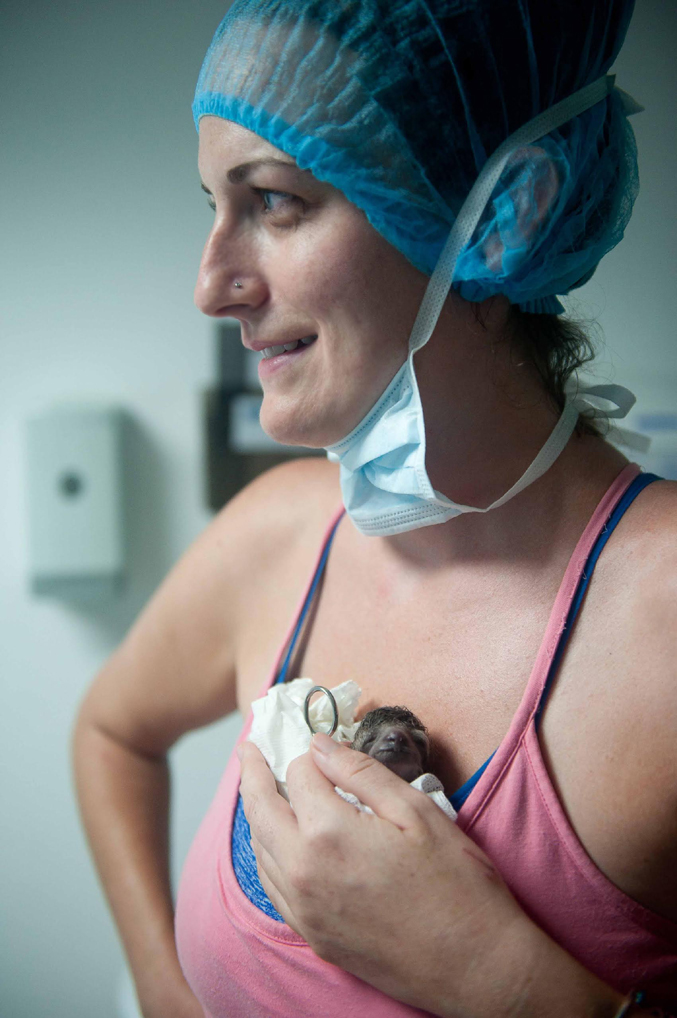
Tell me about the photo of you in scrubs holding the baby sloth against your chest.
That’s a newborn three-toed sloth. Her mother came in pregnant and injured badly after falling from a tree and damaging her brain. After three days in our rescue center, I noticed that she was going into labor. After 36 hours of contractions she still wasn’t delivering, so we took her to another vet and X-rays showed that the baby was breached. Together we performed an emergency C-section. And at least to our knowledge, that was the first ever C-section on a wild three-toed sloth!

It’s a remarkable story!
Holding a newborn baby to your chest is a method called “skin to skin.” It’s used for human babies immediately after surgery to increase their body temperature to reverse hypothermia, which is a common complication in C-section births. It’s a quick and effective method, and it worked.

This adorable baby being bottle fed is an indigenous Squirrel monkey. Are Squirrel monkeys the same as Titi monkeys?
Yes, they are. Titi is a native local name for Squirrel Monkeys (Saimiri oerstedii), but it the name is not really known outside of Costa Rica. If you visit the rescue center, you’ll see squirrel monkeys and Spider Monkeys (Ateles geoffroyi) and Marmosets from Brazil up close, and you’ll learn something fascinating about them.
Moving a species up from a designation of “critically endangered” to “endangered” is a rare reversal in today’s world. And all it really took, essentially, was erecting a series of thick blue ropes!
We rescue wild animals, but we also work very hard to prevent harm to them in the first place.
The leading cause of death for the endemic Titi monkeys is electrocution by high-tension electric wires—an extremely traumatic and painful experience. The second leading cause of death is being hit by cars, which isn’t any fun, either. KSTR erected bridges that offer monkeys and other animals a safe alternate route across the roads of Manuel Antonio. We put them in strategic areas where being electrocuted or hit by a car is likely, and they’ve been very helpful.
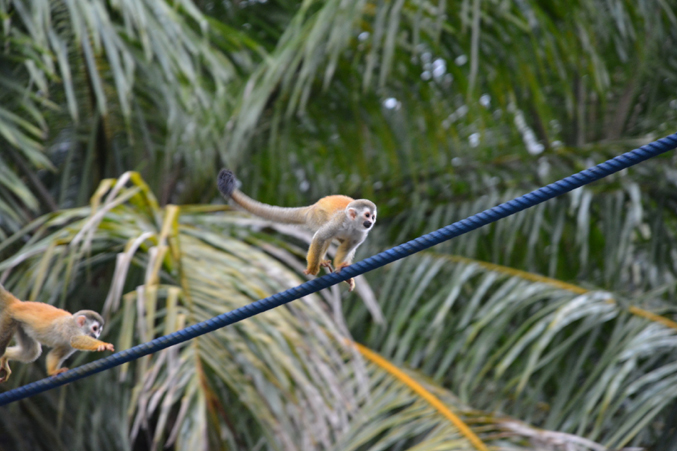
And these bridges are just thick blue ropes?
Yes, and they work perfectly and the monkeys love them! Lots of other animals—including anteaters and sloths—use the monkey bridges, too! When you consider how simple and effective this solution is, the costs of erecting and maintaining bridges is minimal.
I sponsored a monkey bridge and I think is a great gift idea for animal lovers.
Yes, it is—because it is such a positive and hopeful project, and a little goes a long way. Just $10 a month we can provide maintenance on a monkey bridge for an entire year. Several years ago there were approximately 1,200 to 1,500 Titi monkeys, and today the count is up to around 3,000. Yes, that’s remarkable and rare but they’re still endangered. We need to add more monkey bridges so the species can fully recover, so we hope many more people will Sponsor a Monkey Bridge.
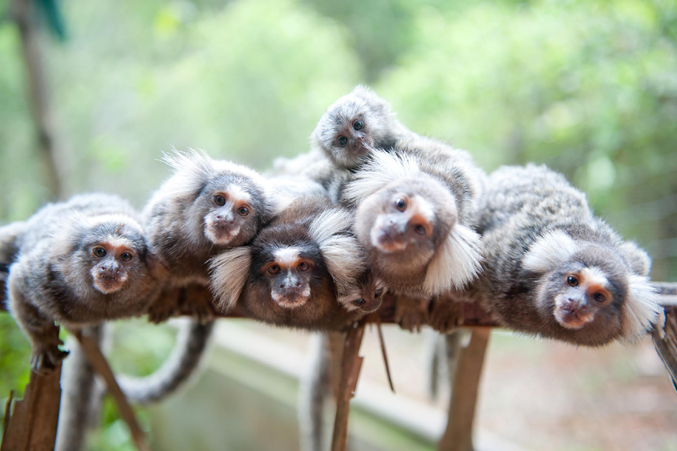
The marmosets at the rescue center aren’t native to Costa Rica, right?
They’re from Brazil, brought here by a retired scientist who was studying them and no longer needed them. They’ve been in captivity for generations, so even if they were in Brazil they wouldn’t be suitable candidates for release.
How do you hand-rear orphaned babies while ensuring that they can be released back into the wild when they’re old enough?
We minimize human contact, so animals that are being rehabilitated for release are not on the tour. The only animals on the tour are the permanent residents, which means they’ve been deemed “unreleasable.” They live indefinitely within the sanctuary. During a small section of the tour, visitors can walk past the clinic and look through the glass window to see wild animals being rehabbed, but the babies can’t really hear what’s going on outside so they’re not affected. We limit human contact, big time.
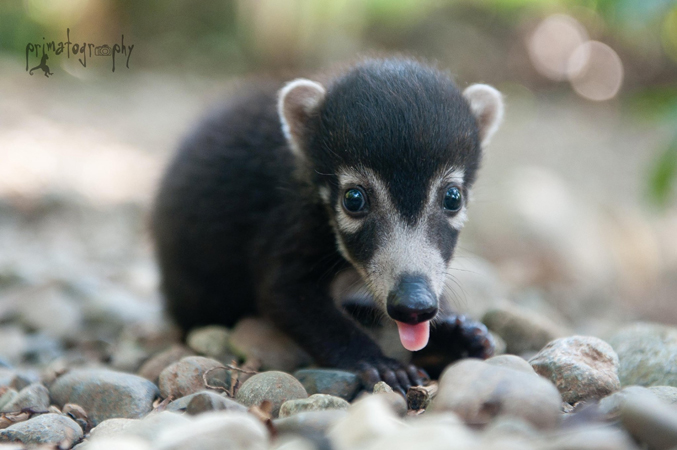
Even though you keep the babies away from visitors, you still have to hand rear them from a very young age. How do you keep them from becoming habituated?
These animals have had a good experience with a human being but they gravitate to their own kind. We put babies with other babies of their own species as often as possible so they’ll have social companionship with a member of their own species and don’t end up entirely dependent on humans. It’s really important to get them with their own kind as soon as they’re ready. We just have to keep pushing them to be emotionally independent. When I’ve raised squirrel monkeys, for example, the babies need social companionship from me when they’re a lot younger, but as soon as I put them with another monkey they’re kinda like, “Who are you?”
So, you have to encourage that space.
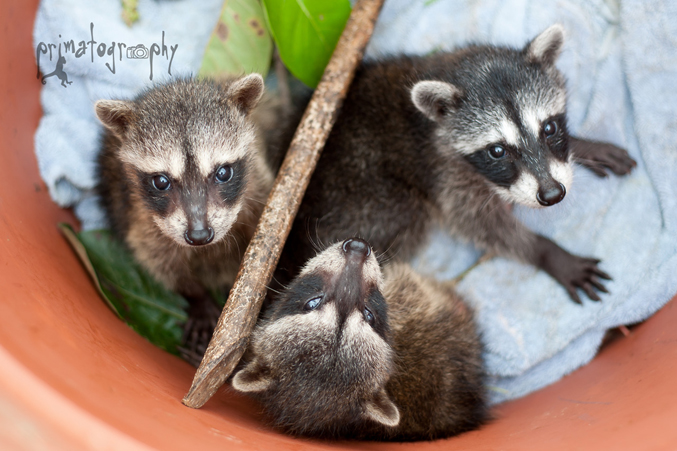
There’s no way that you could raise them being completely hands-off.
They need love and touch to survive. Without that they would just die because they’d be so depressed. It’s a tricky situation, for sure, because they do need you for emotional development and just to learn how to be wild—not just logistically but also emotionally. Then you have to back off when its time, and hopefully they don’t become so habituated that they’ll come up to humans when they’re in the wild.
Would these animals die if this rescue center didn’t exist?
Yes, they would.
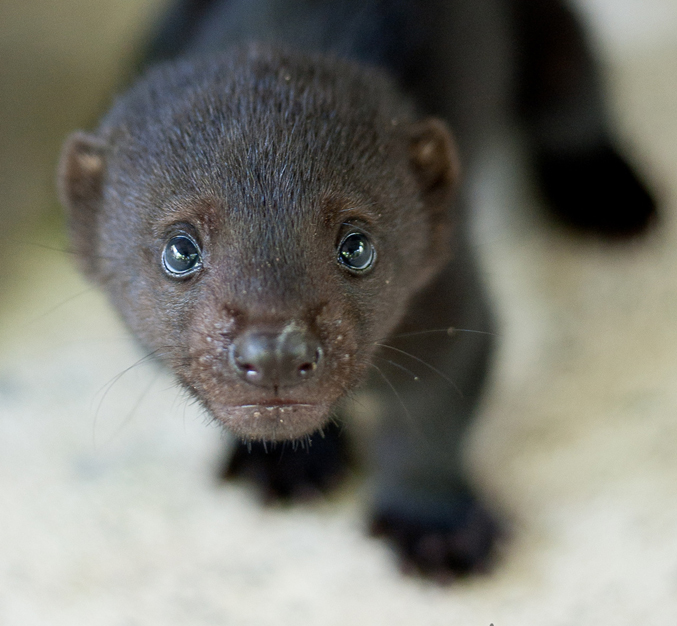
What is this sweet little fellow with the orphan eyes?
He’s a tolomuco! They’re also known as “tayras”. They’re omnivorous, and from the Mustelidae family… think “weasel”. He was found tied up to a tree on a beach, crying. A good Samaritan followed the wailing sounds and found him. No one knows what happened to his mother, but it is highly likely that she was killed so they could catch the baby and sell it as a pet. He was so little he could barely even walk around but he grew up quickly and was full of playful energy. We gave him space to explore and play because we wanted to encourage any wild exploratory behaviors for the day when he got released into the jungle.
We get all sorts of characters here.
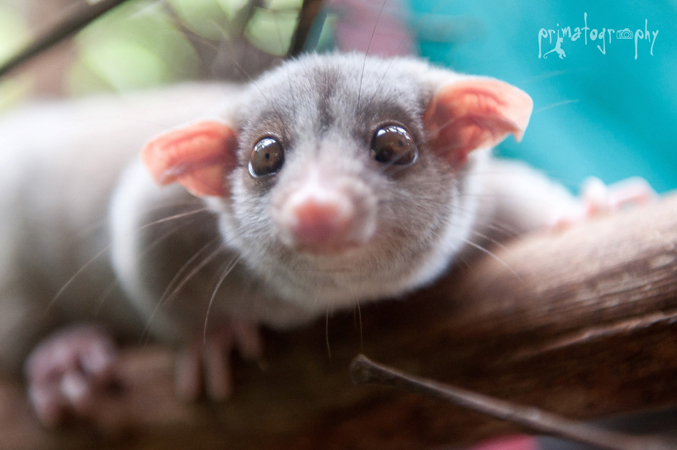
I like Pesto the Woolly Possum!
Pesto was awesome. He was brought to us as a tiny orphan and grew up into a healthy an amazing woolly opossum that could jump, climb and forage for food with great speed and accuracy. So one day, when he was ready, we left his rehab cage door open at night. This began the process of what we call a “soft release”, which allowed Pesto the freedom to take his time coming and going until he felt comfortable enough to permanently leave.

You’re not kidding when you say he was tiny!
Yes. He was teeny-weeny and super cute! We think he’s doing well out there in his new life in the wild.
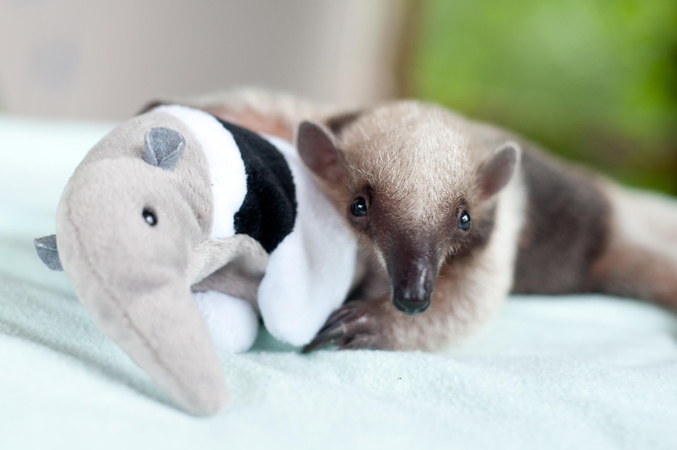
Are most of the baby animals at the center orphaned by humans?
Yes. Unfortunately. Anteaters, for instance, climb trees to hunt for insects but can spend half their time on the ground, where dogs are. Dogs and cars are big problems for anteaters, the most common animal to get hit by cars. Northern tamandua (Tamandua mexicana) babies come into the center fairly regularly, usually because the mother was either killed by a dog or hit by a car.
Do all the patients have names?
Yes, we do name them all, and we have themes for each species. We name the anteaters after comedians because they’re so hilarious. We have Robin, who came in as a baby right around the time that Robin Williams passed away, Lucille Ball, and Whoopie Goldberg. Anteaters are so goofy and play a lot in a cute, clumsy way. They don’t have the best vision, so they maneuver around based mostly on excellent hearing and sense of smell. They get startled pretty easily. We try not to startle them, but we just find ourselves laughing around them a lot.
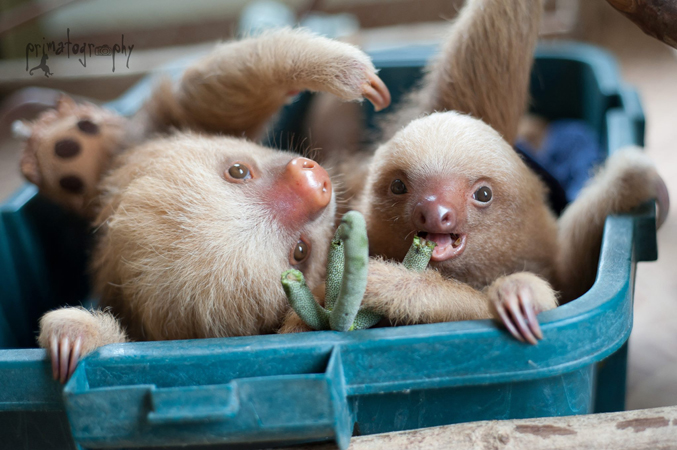
How do you name the sloths?
We give adult three-toed sloths fancy, dignified British names like Winston and Fiona because they present themselves in a very calm and distinguished manner. We name adult two-toed sloths after action heroes like Stallone or Schwarzenegger because they’re strong and aggressive animals. We name the baby sloths after TV show characters. Kermie was named after Kermit the Frog, and Ellen was named after Ellen DeGeneres.

I want to ask you a little about some of my favorite of your fantastic portraits. The adorable baby in the flowery white bowl. What is that?
That’s Hilary the kinkajou, and she’s doing great. We don’t get too many kinkajous; in fact, she was the first baby kinkajou we’ve had since I’ve been here. The scientific name for a kinkajou is Potos flavus but you could easily substitute the “O” for a “U” which would be POTUS which is President of the United States. But she was a girl, so we started to think, well, who is going to the first female president of the United States? So we named her after Hilary Clinton.

What about the gorgeous little ocelot kitten?
Someone killed her mother and kept the baby as a pet. The government confiscated her, and she was brought here to us. We sent her to a specialist feline facility about an hour or two north of us, where they have more expertise in big cats. Not that she’s a big “big cat,” but she’s a wild cat species, which requires a lot of specific expertise. We do a lot of emergency work, so we’ll triage big cats if they come in with wounds or illnesses that are urgent, but then we find the best location for them.

What are some of the things you love the most about your work?
I love the moment that we release them back to the wild. I love feeling like we’re helping them and reversing the damage that’s been done in their lives. We get so many animals for reasons that were caused by humans, like electrocutions, which is probably the number one reason we receive animals. And these electrocutions are so heartbreaking. These animals come in almost completely burnt.
A howler monkey came in with more than 90 percent of her body was burned, including her face. I took before and after photos of her because she’s one of my favorite patients. Her name was Helen. So, releasing her back to her troop and seeing her with her family and friends again after having been with us for 10 months—that’s why I do this.

She survived!
She survived. When she first came in I was extremely concerned and even thought for a minute that maybe it would best that she be euthanized because she was in such bad shape, but we literally looked into each other’s eyes and I just felt that she had this energy that she really wanted to provide. So we did IV fluids, pain meds, antibiotics, the whole nine yards—and 2 months later she was going back to her family.
And the opposite of that: what are the most difficult, challenging things that you face in your work?
The flipside is when they don’t make it, especially when you’ve tried so hard and put everything into them. Sometimes even after months and months of rehabbing, they don’t survive. That is one of the worse feelings you can have because not only do you miss them as individuals—because they each have their own personalities and you care about them—but you also lose that dream of releasing. When they die, you feel like a failure. You feel like you’ve failed them.
This is a calling rather than a job. Why do you do this?
I can’t imagine doing anything else. I’ve always wanted to devote my life to doing something that helps animals in the best way possible. And the thing that I like about my position at KSTR is that not only are we helping animals on a daily basis—as in physically helping individuals—but we’re also spreading the message about conservation and animals on a larger scale.
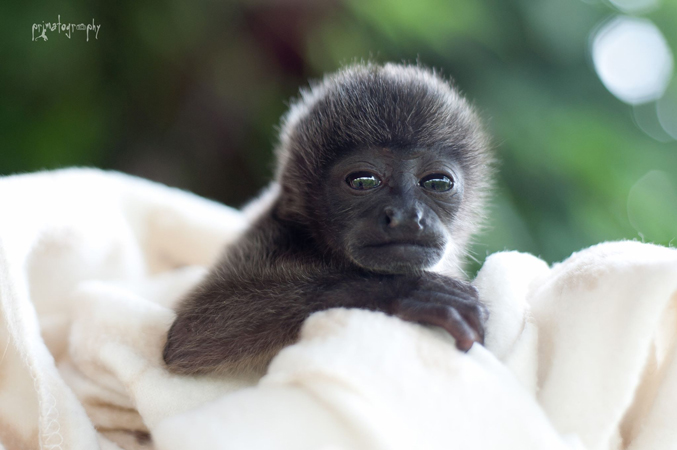
What are some of the lessons you’ve learned from animals?
One of the biggest lessons is once you blur the line between human and animal, once you realize they’re important (i.e. they’re similar to us, like the primate connection), then it’s really hard to figure out where to draw that line again.
Humans, of course, are animals. We just tend to forget that because as a species we’re so full of ourselves.
We’re a pretty self-centric species and we’re not always very nice to each other, obviously. But we are negatively affecting animals and their environment, so it’s the right thing to do to try to reverse that. And also, we need them. Without animals we would have no forests, and if we had no forests we would die. Everybody is interconnected, and we need each other to survive. So if we don’t care about what’s going on with the animals in the forests, then we’re basically saying that we don’t care about ourselves.
What are some of the most common questions you get asked about your work or your lifestyle?
I find that people often seem—amazed—that I would want to live in the jungle or that I would want this to be my life. They think it’s cool but they also find it—amazing. Which is always so surprising to me because it just feels like I have to do this. I’ve had people say, “Oh, you’re a hero!” I’m not a hero. I don’t feel like a hero, I just feel like I’m doing what comes naturally and what makes sense and what I feel like I have to do. So while being called a hero is flattering, it always makes me feel a bit uncomfortable. I’m just doing the best I can.
Another random question people often ask me is, “What do miss about living in the States the most?”
What do you miss about living in the States the most?
Convenience. Having whatever I want whenever I want it and being able to drive to go and get it myself. But that’s about it.
Other than donating, which is always helpful, how else can people help the animals?
Donating is always helpful. But also, don’t support the exotic wildlife pet trade. People in the United States fuel the pet trade in other countries, for sure. It’s not removed. Just because you buy the animal in some pet store in Florida, for instance, doesn’t mean its mother wasn’t killed. We can definitely make a change that way.

ONLINE RESOURCES
Primatographer on Twitter @Primatography
Slothlove #slothlove
Kids Saving the Rainforest (KSTR)
KSTR’s Wildlife Rescue Center.
The Sloth Institute Costa Rica
All images are copyright protected and are published with permission. To request permissions for use, please contact Sam Trull at Primatography
#WomenWildernessWildlife


1 comment on “World’s Cutest In-Patients”